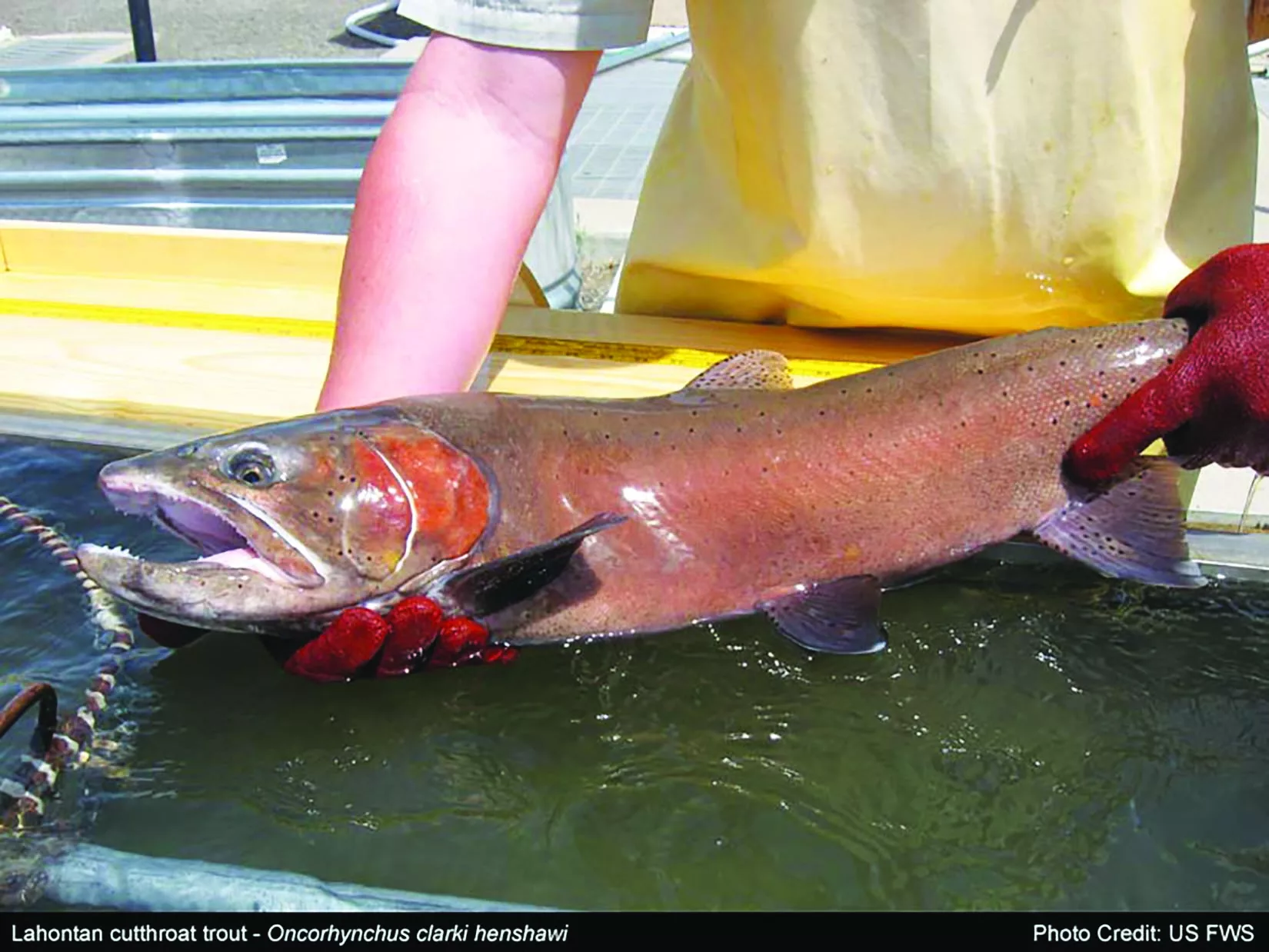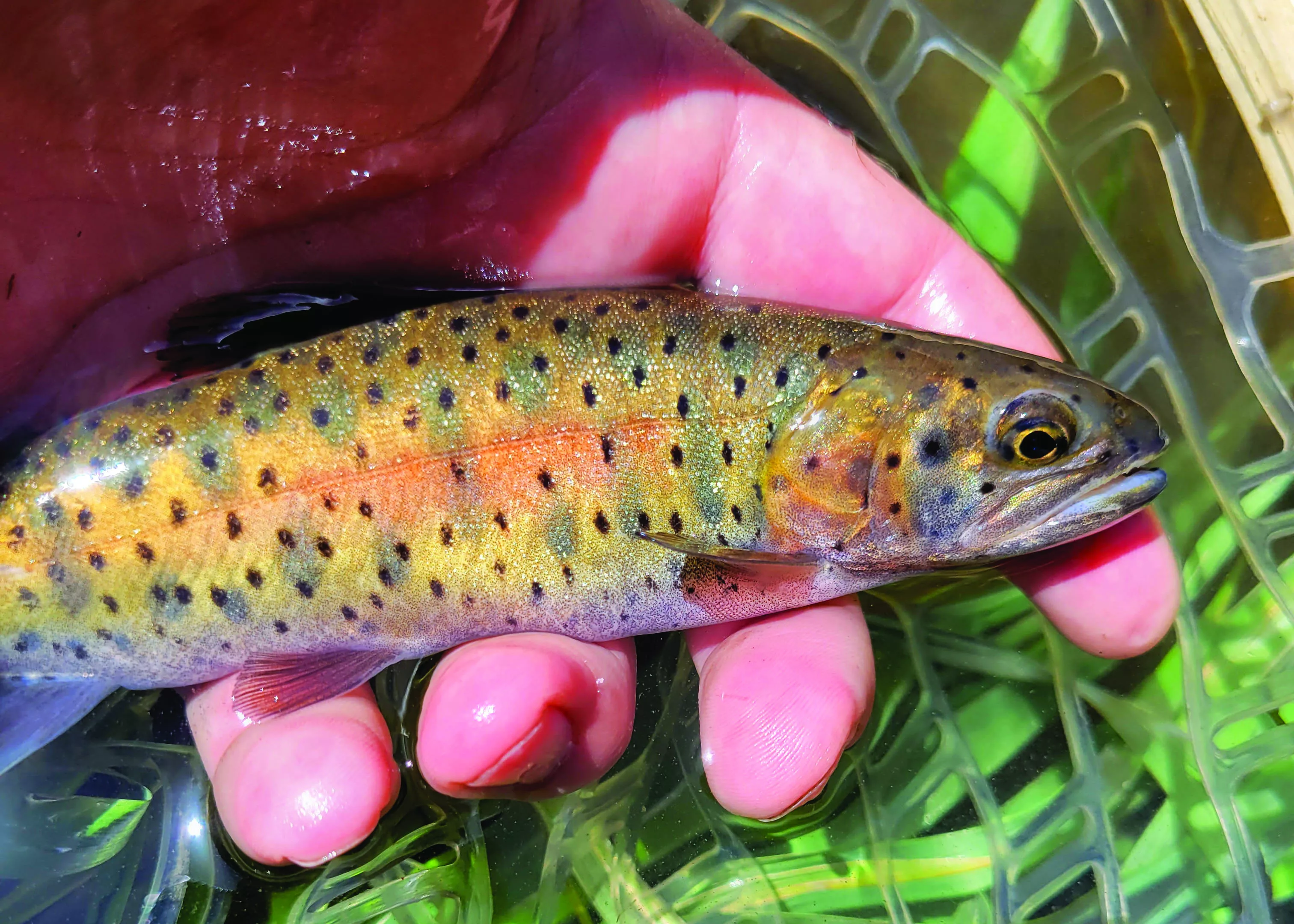
By Jim Knox
I will never forget my first glimpse of a wild Cutthroat trout. I was walking the brushy banks of the North Fork of the Tongue River tucked within the shoulders of Wyoming’s Bighorn Mountains. I saw a flicker of motion in the silvery sparkle of the Rocky Mountain stream. A shadow was holding steady against the swift current, nose pointed upstream. A stealthy approach and a few lucky casts later, and a little fish rested deep within my net. It was a picture-perfect Yellowstone Cutthroat with an olive-green back, gold, and silver flanks, fine black speckling, an orange-red gill plate, and a namesake Cherry red slash mark below its lower jaw. I studied it briefly yet minutely before releasing it back to its native water. With a flick of its tail, it resumed its place midstream as if I had never interrupted its scan for insect prey.
The Cutthroat Trout is an iconic fish—approaching legend among anglers and outdoorspeople. Requiring rushing, clean, highly oxygenated waters, these fish have become synonymous with the stunning wilderness waters they inhabit. Possessing a streamlined form mimicked by engineers to produce supersonic aircraft, Formula One racers, and high-speed trimaran hulls, they represent the pinnacle of Mother Nature’s design prowess. To spy one in swift, swirling currents is to see a creature shaped by the flow of water and time.
Like most successful species, the Cutthroat’s basic form and function has adapted to fulfill unique ecological subspecies roles throughout its range. These fish have with a remarkable comeback story. Inhabiting the isolated Lahontan Basin encompassing Northern Nevada, Southeastern Oregon, and Northeastern California, these fish evolved in this vast ancient lake habitat. As the lake—more akin to an inland sea—expanded and contracted over millions of years, these specialists adapted to deep, cold, and often highly saline conditions that other fish could not withstand. Over time, the ever-changing and vitally demanding conditions forged a peerless creature.
The Lahontan Cutthroat Trout, Oncorhynchus clarkii henshawi, is a unique animal. Hatching in headwater mountain streams, these fish historically migrated downstream and lived their lives in deep ancient waters, such as Nevada’s Pyramid Lake, where they hunted their fellow trout, grew with each season, and attained massive proportions. Reaching lengths of more than four feet and weights in excess of 41 pounds, these beasts had no rival. Incredibly, tribal, gold miner, and trapper accounts from the region describe pioneering-era monsters topping 60 pounds—making the Pyramid Lake strain of the Lahontan Cutthroat, the largest true trout on the planet.
Yet even giants have their vulnerability. Victims of habitat degradation from mining, timber cutting and damming of streams, unchecked fishing harvests, and competition from non-native trout species, the giants became scarce and eventually disappeared from their ancestral waters. By 1941, the giant Pyramid Lake form of the Lahontan Cutthroat was feared extinct.
Decades passed and hope waned. In 1975, a Bureau of Land Management employee was searching for genetically pure strains of related and imperiled Bonneville Cutthroats in the high desert peaks along the Utah-Nevada border when he unexpectedly struck gold. In a tiny trickle of a mountain stream known as Pilot Peak he found Cutthroats with unusual features and immediately sent them to the lab for analysis. These small trout were examined by the Connecticut native, trout expert, and godfather of trout taxonomy, Dr. Robert Behnke. While their form gave Behnke a clue as to their true identity, their genetic sequencing analysis confirmed the little trout were a match for Pyramid Lake Strain Lahontan Cutthroats. But how?
Scant records from the Nevada State Wildlife Commission revealed the existence of a program to spread Pyramid Lake fish to small streams across the state in the early 20th century. Deemed unsuccessful, this effort to boost the population of the official Nevada State Fish was lost to the anonymity of time. Tiny and forgotten, this last known Pilot Peak population miraculously endured wildfires, drought, and geographic isolation to survive. By 2006, expanding upon a successful hatchery program, the descendants of the Pilot Peak fish were reintroduced to their native habitat to swim the deep frigid waters of Pyramid Lake once again. With Pyramid Lake Lahontan Cutthroats now regularly topping 20 pounds, the effort to restore this mythic species is an unqualified success.
The Lahontan Cutthroat has so much to teach us. Despite its apparent invulnerability, these giants were susceptible to a suite of human induced threats. While vulnerable to human change, these creatures withstood the harshest conditions nature could throw at them. A single wise and far-sighted effort to safeguard their future—an investment in their tenacious nature—paid off. Embodying resilience in the face of adversity, they endured.
In life, we are so frequently confronted by hosts of threats. While we should continue to invest in the wild world and wild creatures around us, we must also invest in ourselves and each other. It is the knowledge that we can persist and thrive not despite such challenges, but because of such challenges, that bestows hope. Adversity shapes excellence just as the flow of a stream shapes the body of a trout and those that would someday reign, begin their journey as small versions of the giant within.
Jim Knox serves as the Curator of Education for Connecticut’s Beardsley Zoo and as a Science Adviser for The Bruce Museum. His passions include studying our planet’s rarest creatures and sharing his work with others who love the natural world.




